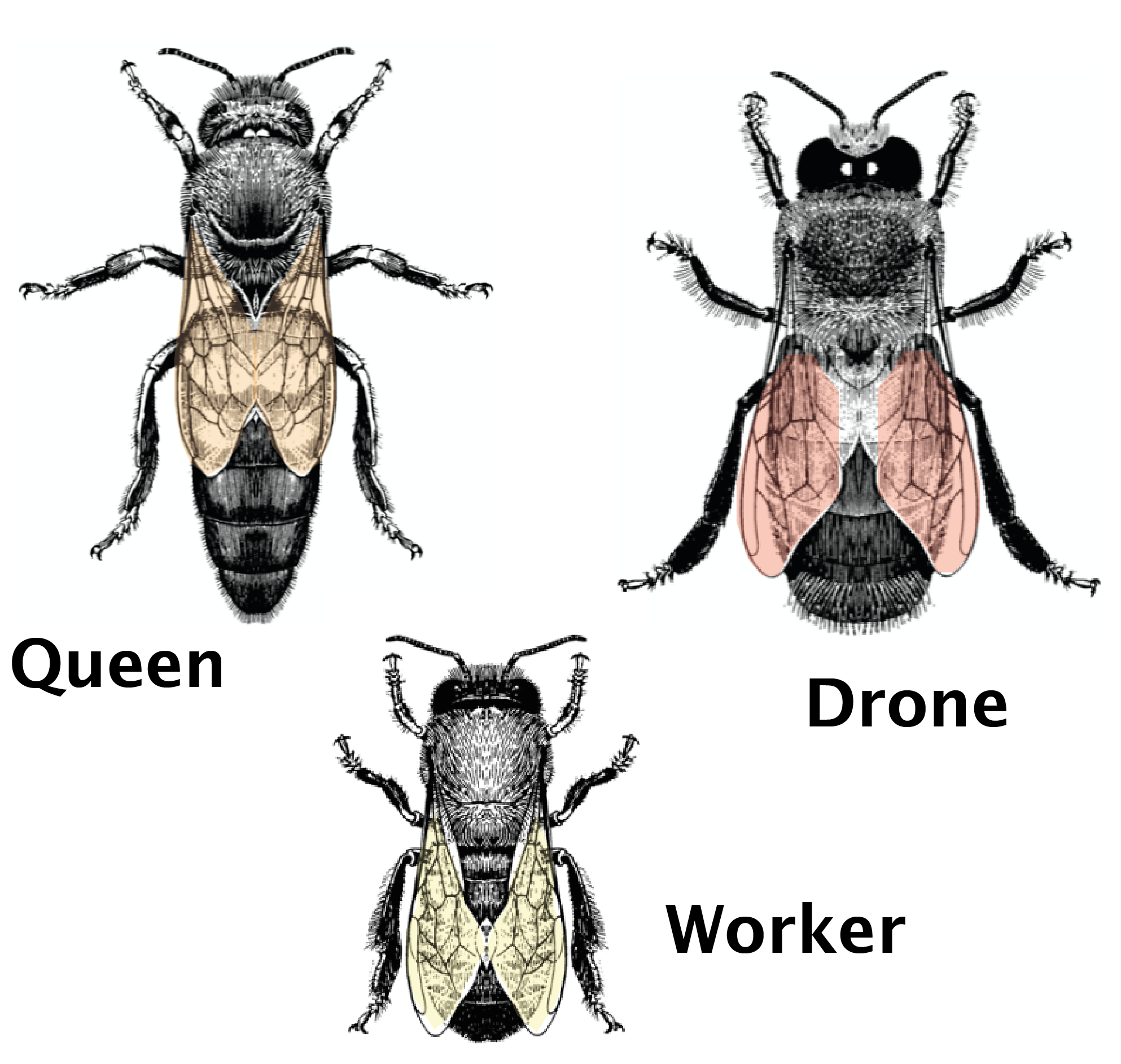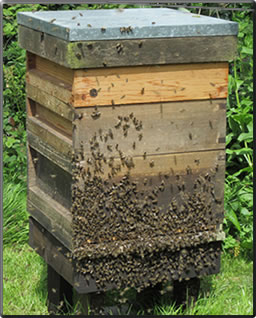Genetics 2F
The DNA possessed by the bees in the colony comes from the queen and the numerous drones with which she has mated. The queen herself inherits her own DNA from her mother and her drone father. Each drone carries his own unique DNA.
Genes are found at loci along the 16 pairs of chromosomes in the nucleus of each cell. Each gene (often in combination with others) is responsible for a specific trait shown by the colony. In particular the csd gene exists in 19 allelic variants.
Genes are found at loci along the 16 pairs of chromosomes in the nucleus of each cell. Each gene (often in combination with others) is responsible for a specific trait shown by the colony. In particular the csd gene exists in 19 allelic variants.
The Genetic Structure of the Colony
This page summarizes the 4 levels of genetic relationships within the colony.
Namely the gene, the castes, the worker subsets, and the colony as a macro organism.
DNA - the Genome

the genes
This page summarizes the 4 levels of genetic relationships within the colony.
Namely the gene, the castes, the worker subsets, and the colony as a macro organism.
DNA - the Genome
the genes
The honey bee colony consists of three distinct castes:
The drone is haploid i.e. results from an unfertilized egg. The sole function of the drone is to pass on his set of chromosomes when he gets the chance to mate with a queen. The number of drones which are successful in mating represents the colony's fitness in so far as genes are passed on to the next generation.
Otherwise the drone does not appear to contribute very much to the success of the colony and does not influence any trait. The number of drones within the colony varies widely from zero in the winter to many hundreds at the summer peak.
The queen and her workers are diploid females which develop because of a different diet fed to the respective larvae. The only function of the queen is to lay eggs: she is normally the only reproductive female in the colony.
The workers can be subdivided into various teams each performing a specific task. Workers are allocated a task according to age. Starting with nursing duties and finishing with foraging.
Each caste exudes its own set of pheromones.
Normally the colony consists of two generations: the queen can be one or two years older than her workers. But all bees in the colony share the same mitochondrial DNA which acts as a marker for the queen line.
The drone is haploid i.e. results from an unfertilized egg. The sole function of the drone is to pass on his set of chromosomes when he gets the chance to mate with a queen. The number of drones which are successful in mating represents the colony's fitness in so far as genes are passed on to the next generation.
Otherwise the drone does not appear to contribute very much to the success of the colony and does not influence any trait. The number of drones within the colony varies widely from zero in the winter to many hundreds at the summer peak.
The queen and her workers are diploid females which develop because of a different diet fed to the respective larvae. The only function of the queen is to lay eggs: she is normally the only reproductive female in the colony.
The workers can be subdivided into various teams each performing a specific task. Workers are allocated a task according to age. Starting with nursing duties and finishing with foraging.
Each caste exudes its own set of pheromones.
Normally the colony consists of two generations: the queen can be one or two years older than her workers. But all bees in the colony share the same mitochondrial DNA which acts as a marker for the queen line.
If it might be assumed that the queen mates with on average 10 drones, then there are 20 subsets of workers in the colony. Workers within a subset share 75% of their genome, workers from different subsets share 25%. Each subset inherits a variation in any one trait such as hygienic behaviour, resistance to disease, foraging behaviour etc. It may well be that not all subsets show the same propensity towards a particular trait, a particular subset might take on one particular task i.e. become a specialist say towards guard duty.
The colony acts as a macro organism. The behaviour of the bees within the colony is dependent on the genetic makeup of all the subsets. Communication within the colony is through pheromones: e.g. between the queen and workers; the queen and drone; between workers.
Of the 30 0000 bees which might make up the colony, only one bee is of interest to the beekeeper, namely the queen. And the performance of the colony over a season is for the most part judged by the so called quality of the queen.
Criteria used to judge the colony include: honey yield, gentleness/stinging, calmness on the comb, resistance to disease, and body colour. The beekeeper might use this assessment to decided from which colony the next breeder queen is to come. However, there is a difficulty which is perhaps not well appreciated when the queen has been openly mated. The egg laid by the queen which is to become the new queen could have been fertilized by a drone whose genes possess little of the qualities required. This is a gamble the beekeeper takes and explains why the performance of the new queen could be a disappointment.
Of the 30 0000 bees which might make up the colony, only one bee is of interest to the beekeeper, namely the queen. And the performance of the colony over a season is for the most part judged by the so called quality of the queen.
Criteria used to judge the colony include: honey yield, gentleness/stinging, calmness on the comb, resistance to disease, and body colour. The beekeeper might use this assessment to decided from which colony the next breeder queen is to come. However, there is a difficulty which is perhaps not well appreciated when the queen has been openly mated. The egg laid by the queen which is to become the new queen could have been fertilized by a drone whose genes possess little of the qualities required. This is a gamble the beekeeper takes and explains why the performance of the new queen could be a disappointment.
the three castes


the worker subsets -
each with a different drone father
each with a different drone father

the colony - the macro organism


